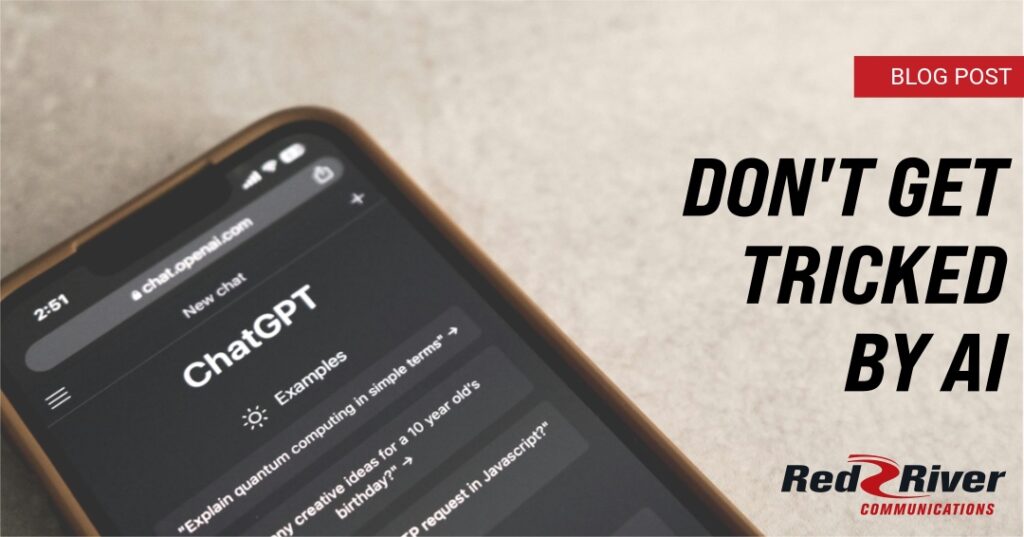
Scammers are getting sneakier with AI. Learn how to spot deepfakes, fake voices, and AI-generated scams before they trick you. Stay one step ahead with tips from Red River Communications.
Artificial Intelligence (AI) generators are becoming increasingly sophisticated and accurate at making photos, videos, and messages look real. And while it can be fun to play with the various AI tools, chat platforms, and content generators, dangers are lurking with those who would seek to do harm.
With the rapid spread of AI content comes a rise in misleading deepfakes, or altered images, videos, or audio. According to an infographic released by the FBI and the American Bankers Association, “[Deepfakes] may depict people you know — including friends and family — or public figures including celebrities, government officials, and law enforcement.”
Fake images and messages, including deepfakes, are increasingly being used to trick people into believing false information or even sharing private personal data with bad actors. As AI-created media becomes more widely available online, it’s essential to learn how to distinguish between human-created content and AI-generated content.
Red River Communications has been closely monitoring AI developments and emerging trends, and we aim to help protect you from deepfakes and malicious actors utilizing simulated content.
Pop Quiz
AI can be used to create fake news, scam calls, or even fake videos of politicians, celebrities, or current events. These tricks can spread fast online and confuse people. Being able to pause and ask, “Is this real?” protects you and your loved ones.
Take a look at this “Detect Fakes” quiz from Northwestern University and test your skills on identifying real versus AI-created images. Then, read on to learn how to identify fakes and test again.
Don’t feel bad if you don’t perform well. AI is becoming so advanced that even professionally trained eyes struggle to distinguish what’s real from what’s fake. The most important takeaway is to fact-check copy, images, and even videos you see online before believing the content is real.
Scams Are Getting Trickier with AI
The most significant risks to consumers right now are scammers using AI to make their schemes more realistic. In fact, in 2023, the FTC released a consumer alert about scammers using AI to make family emergency schemes and “grandparent scams” seem legitimate.
Criminals are using AI voice cloning tools to replicate audio pulled from videos and voice recordings posted online to sound like your loved one, often claiming they’re in trouble and need money. Likewise, your own voice or face could be copied from social media and used to trick others into sharing money or information.
AI is also being used in phishing scams sent through emails and texts. These scammers can more quickly and easily replicate legitimate-looking organizational messages with fewer spelling mistakes. AI chatbots disguised as investors or romantic partners can carry on conversations to earn your trust.
Protecting Yourself
The general rule of thumb for protecting yourself online has always been to be careful about what you share on social media, including photos, birthdays, and videos with voices, so that this information cannot be used against you or loved ones via deepfakes. Create code words with your loved ones in case an emergency does arise.
Use strong passwords and two-factor authentication to make it harder for AI-driven phishing tools to break in. It takes mere seconds for a strong tool to break through weak passwords, making accounts hard, or often impossible, to recover without two-factor authentication.
Finally, be suspicious:
- Double-check any urgent call or text asking for money or personal details. Hang up and call the person back directly.
- If an offer sounds too good to be true, it likely is.
- Before sharing information or photos on social media, verify the source and fact-check with reliable sources.
Spotting Fake Content
As we stated previously, even professionals struggle to identify AI-generated content and deepfakes, and this challenge will only intensify as the technology advances. However, there are some basic features you can look for:
- Photos: Look for extra fingers, warped backgrounds, mismatched earrings, unrealistic hair and teeth, unnatural shadows, glare in glasses or windows, reflections in water, and unnaturally perfect skin (real skin will have texture and imperfections).
- Videos: In addition to all the features of a still photo, pay attention to the following in video: lips and voice not quite in sync, flat or unnatural voice, blinking that is either too slow or too rapid, stiff movements, and odd movements in shadows.
- Writing: Notice whether the content sounds too formal or repetitive, or offers only generic advice that doesn’t answer specifics, or if responses to chats are instant and vague.
AI Detectives
When in doubt about whether you’ve encountered an AI-generated image or message, you can turn to AI detection tools online. We recommend verifying against two tools, as they often look for different features to identify AI content.
Photos & videos:
- AI or Not – detects images, music, text, and video
- Attestiv – scans for deepfakes and alterations to videos
Writing:
- GPTZero – scans text to see if it’s AI-written
- Copyleaks AI Detector – another text detector
- QuillBot – also has a plagiarism detector
Profiles:
- Use reverse image search on Google Images or TinEye to check if a profile picture is stolen.
AI: Friend or Foe?
While scammers are getting extremely sophisticated with deepfakes and generated content, AI can still be helpful at work and fun to play with. The goal isn’t to avoid AI, but to be aware of how to spot the tricks.
Red River Communications cares about keeping you safe online and connected to trustworthy information.
Stay alert, avoid oversharing online, double-check shared content, and use tools when unsure.